bis-Dehydroxy-Curcumin triggers mitochondrial-associated cell death in human colon cancer cells through ER-stress induced autophagy
- PMID: 23326480
- PMCID: PMC3543386
- DOI: 10.1371/journal.pone.0053664
bis-Dehydroxy-Curcumin triggers mitochondrial-associated cell death in human colon cancer cells through ER-stress induced autophagy
Abstract
Background: The activation of autophagy has been extensively described as a pro-survival strategy, which helps to keep cells alive following deprivation of nutrients/growth factors and other stressful cellular conditions. In addition to cytoprotective effects, autophagy can accompany cell death. Autophagic vacuoles can be observed before or during cell death, but the role of autophagy in the death process is still controversial. A complex interplay between autophagy and apoptosis has come to light, taking into account that numerous genes, such as p53 and Bcl-2 family members, are shared between these two pathways.
Methodology/principal findings: In this study we showed a potent and irreversible cytotoxic activity of the stable Curcumin derivative bis-DeHydroxyCurcumin (bDHC) on human colon cancer cells, but not on human normal cells. Autophagy is elicited by bDHC before cell death as demonstrated by increased autophagosome formation -measured by electron microscopy, fluorescent LC3 puncta and LC3 lipidation- and autophagic flux -measured by interfering LC3-II turnover. The accumulation of poly-ubiquitinated proteins and ER-stress occurred upstream of autophagy induction and resulted in cell death. Cell cycle and Western blot analyses highlighted the activation of a mitochondrial-dependent apoptosis, which involves caspase 7, 8, 9 and Cytochrome C release. Using pharmacological inhibitions and RNAi experiments, we showed that ER-stress induced autophagy has a major role in triggering bDHC-cell death.
Conclusion/significance: Our findings describe the mechanism through which bDHC promotes tumor selective inhibition of proliferation, providing unequivocal evidence of the role of autophagy in contrasting the proliferation of colon cancer cells.
Conflict of interest statement
Figures
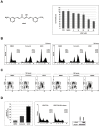
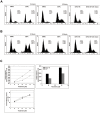
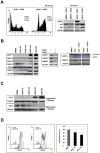
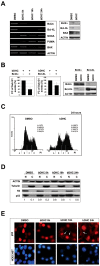
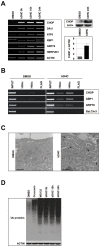

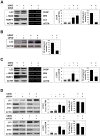

Similar articles
-
FK-16 derived from the anticancer peptide LL-37 induces caspase-independent apoptosis and autophagic cell death in colon cancer cells.PLoS One. 2013 May 20;8(5):e63641. doi: 10.1371/journal.pone.0063641. Print 2013. PLoS One. 2013. PMID: 23700428 Free PMC article.
-
B5, a thioredoxin reductase inhibitor, induces apoptosis in human cervical cancer cells by suppressing the thioredoxin system, disrupting mitochondrion-dependent pathways and triggering autophagy.Oncotarget. 2015 Oct 13;6(31):30939-56. doi: 10.18632/oncotarget.5132. Oncotarget. 2015. PMID: 26439985 Free PMC article.
-
Curcumin synergizes with 5-fluorouracil by impairing AMPK/ULK1-dependent autophagy, AKT activity and enhancing apoptosis in colon cancer cells with tumor growth inhibition in xenograft mice.J Exp Clin Cancer Res. 2017 Dec 22;36(1):190. doi: 10.1186/s13046-017-0661-7. J Exp Clin Cancer Res. 2017. Retraction in: J Exp Clin Cancer Res. 2022 Jun 10;41(1):197. doi: 10.1186/s13046-022-02409-y. PMID: 29273065 Free PMC article. Retracted.
-
Phytochemical-mediated modulation of autophagy and endoplasmic reticulum stress as a cancer therapeutic approach.Phytother Res. 2024 Sep;38(9):4353-4385. doi: 10.1002/ptr.8283. Epub 2024 Jul 3. Phytother Res. 2024. PMID: 38961675 Review.
-
Autophagy as a potential therapeutic target in regulating improper cellular proliferation.Front Pharmacol. 2025 May 15;16:1579183. doi: 10.3389/fphar.2025.1579183. eCollection 2025. Front Pharmacol. 2025. PMID: 40444035 Free PMC article. Review.
Cited by
-
Synergistic chemopreventive effects of curcumin and berberine on human breast cancer cells through induction of apoptosis and autophagic cell death.Sci Rep. 2016 Jun 6;6:26064. doi: 10.1038/srep26064. Sci Rep. 2016. PMID: 27263652 Free PMC article.
-
Curcumin targets the TFEB-lysosome pathway for induction of autophagy.Oncotarget. 2016 Nov 15;7(46):75659-75671. doi: 10.18632/oncotarget.12318. Oncotarget. 2016. PMID: 27689333 Free PMC article.
-
Novel Approaches of Dysregulating Lysosome Functions in Cancer Cells by Specific Drugs and Its Nanoformulations: A Smart Approach of Modern Therapeutics.Int J Nanomedicine. 2021 Jul 26;16:5065-5098. doi: 10.2147/IJN.S321343. eCollection 2021. Int J Nanomedicine. 2021. PMID: 34345172 Free PMC article. Review.
-
Polyunsaturated fatty acids trigger apoptosis of colon cancer cells through a mitochondrial pathway.Arch Med Sci. 2015 Oct 12;11(5):1081-94. doi: 10.5114/aoms.2015.54865. Arch Med Sci. 2015. PMID: 26528354 Free PMC article.
-
In Situ Immunofluorescent Staining of Autophagy in Muscle Stem Cells.J Vis Exp. 2017 Jun 12;(124):55908. doi: 10.3791/55908. J Vis Exp. 2017. PMID: 28654079 Free PMC article.
References
-
- Taylor RC, Cullen SP, Martin SJ (2008) Apoptosis: controlled demolition at the cellular level. Nat Rev Mol Cell Biol 9: 231–241. - PubMed
-
- Igney FH, Krammer PH (2002) Death and anti-death: tumour resistance to apoptosis. Nat Rev Cancer 2: 277–288. - PubMed
-
- Cuervo AM (2004) Autophagy: many paths to the same end. Mol Cell Biochem 263: 55–72. - PubMed
Publication types
MeSH terms
Substances
LinkOut - more resources
Full Text Sources
Other Literature Sources
Research Materials
Miscellaneous

